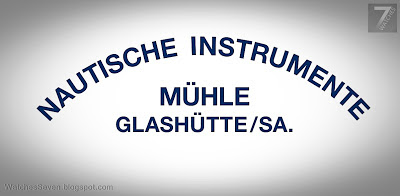
Muhle-Glashutte - Marinus Chronograph Special Edition NEW
Basel 2012
Special Edition Fulda Challenge of 250 Pieces
Mühle-Glashütte is currently taking a particularly sporty approach: The family company from the German town of Glashütte will be presenting not one, but three new chronograph watches at the Baselworld 2012 watch and jewellery show. The Terranaut I Trail and Terrasport I Chronograph are new additions to the company’s range of “Sporty Instrument Watches” and the Marinus Chronograph was developed as a limited special edition for an Arctic decathlon, the Fulda Challenge.
Mühle-Glashütte announce the new MARINUS Chronograph SE Fulda Challenge. It features a solid stainless steel case, which has been coated with DLC, fitted with a sapphire crystal and has a water-resistance of 30ATM. A tough and hardy dive watch - that has qualified for the 2012 Fulda Challenge of which Mühle-Glashütte were the official timekeeper. The watch was exposed to extreme elements and temperatures as low as -40⁰C as it made its way across 1,500 kilometers of Canada's Yukon territory.
Mühle-Glashütte The Marinus Chronograph is distinctive and unscathed as it emerges from the water. But the watch is no longer satisfied with tackling just one element. Whether surfing, snowboarding, sailing or snowshoeing: this outdoor timepiece from Mühle-Glashütte also stands up to the challenges of snow and ice. The Marinus Chronograph has qualified for the Fulda Challenge 2012 thanks to its striking character and is now being launched as a special limited edition.
The strengths of the Marinus Chronograph are evident at a glance: its solid stainless steel case with a black highly resistant DLC coating (diamond like carbon) and 44 mm diameter can live up to any challenge. With its domed 2.5 mm thick sapphire crystal and a resistance to test pressures of 30 ATM, the Marinus Chronograph stands up to external influences such as temperature fluctuations, salt water and changes in pressure. These are all valued properties in the extreme conditions of the Fulda Challenge.
This Arctic decathlon takes place every year in the Yukon Territory in Canada. Athletes battle against the cold along the 1,500 km route as well as tackling the challenges of the individual disciplines which include dog sledding, skijoring and a half marathon at -40⁰C. Mühle-Glashütte took part in the extreme event for the first time this year as the official timekeeper. To mark this commitment, a limited edition series of 250 Marinus Chronograph models was released.
The fact that you can tell the time with the Marinus Chronograph in virtually any conditions is all thanks to the Mühle chronograph movement MU 9408. The patented woodpecker neck regulation guarantees accuracy even under the harshest of conditions.
A 48-hour power reserve, stop-seconds mechanism and fast date corrector complete the technical features of this watch.
The non-reflective sapphire crystal offers an unrestricted view of the black watch face at all times; the white numerals and two totalizers stand out clearly from the background. The uncluttered design means that the small seconds display and minutes counter can be viewed at a glance. The one-sided rotating bezel with its red ceramic insert stands out easily against the otherwise black design of the watch. Thanks to the hands, numerals and indices coated with Super-LumiNova, the watch offers optimal legibility even in dark conditions or under water. The light spot at the zero point on the bezel enhances this further.
Equipped with all of these properties, the Marinus Chronograph can stand up to any challenge, regardless of conditions. This timepiece is the optimal partner for extreme athletes and outdoor enthusiasts who live their lives at the limit.
Movement:
MU 9408, automatic with woodpecker neck regulation, Glashütte three-quarter plate and characteristic surface finishes, Quickset mechanism, stop second, 48-h power reserve
Case:
Case:
Stainless steel with black DLC coating. 2.5 mm thick, domed and anti-glare sapphire crystal,
Screw-in crown. Ø 44,0 mm; H 16,0 mm.
Water-resistant to 30 bars.
Strap:
Screw-in crown. Ø 44,0 mm; H 16,0 mm.
Water-resistant to 30 bars.
Strap:
Rubber or stainless steel strap with extension and security folding clasp made of stainless steel
Dial
Dial
Black. Hour markers and hands coated in Super- LumiNova
Price: 3,500 Euro
--------------------------------------------
Contact details
Tel. +49 711/ 36 53 37 78
Fax +49 711 / 36 53 37 89
E-Mail: PRmuehle-glashuette@convensis.com
--------------------------------------------------------------
www.facebook.com - Muehle Glashuette GmbH
---------------------------------------------------------------------
www.Muehle-Glashuette.de
Price: 3,500 Euro
--------------------------------------------
Contact details
Tel. +49 711/ 36 53 37 78
Fax +49 711 / 36 53 37 89
E-Mail: PRmuehle-glashuette@convensis.com
--------------------------------------------------------------
www.facebook.com - Muehle Glashuette GmbH
---------------------------------------------------------------------
www.Muehle-Glashuette.de




